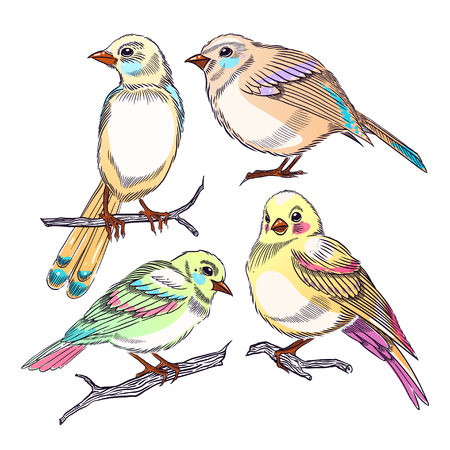Introduction to Feeding Young Birds in India
Proper nutrition is crucial for the healthy growth and survival of newborn and young birds, especially in a diverse country like India. From the lush forests of Kerala to the arid lands of Rajasthan, Indias unique environmental conditions influence the types of food available for both wild and domesticated birds. In Indian culture, birds are often considered auspicious and are cared for with great attention. Ensuring that baby birds receive the right nutrients during their formative days supports robust development, strengthens immunity, and increases their chances of thriving in their natural or domestic habitats. Recognizing the interplay between local traditions, climate, and available resources helps Indian bird lovers provide optimal care for these delicate creatures.
2. Understanding the Needs of Newborn Birds
Caring for newborn and young birds in India, such as Indian mynas, sparrows, and parakeets, requires a good understanding of their unique dietary needs. Hatchlings (just emerged from eggs) and nestlings (still dependent on parents for food) have specific nutritional requirements that differ based on species and development stage. Many common Indian garden birds are altricial, meaning they hatch helpless and blind, relying entirely on adults or caregivers for frequent feeding with high-protein diets to support rapid growth.
Dietary Requirements by Species
| Bird Species | Hatchling Diet | Nestling Diet |
|---|---|---|
| Indian Myna | Insect protein (ants, small worms), soft fruits | Gradual inclusion of grains, soft fruits, and more insects |
| Sparrow | Soft-bodied insects, semi-digested seeds via parent feeding | Crushed grains, seeds, occasional greens, insects |
| Parakeet | Regurgitated food from parents: grains mixed with fruit pulp | Soft fruits, soaked grains, millet sprays, tender greens |
Challenges in Feeding Newborn Birds
- Frequent Feeding: Newborns require feeding every 15-30 minutes during daylight hours due to their fast metabolism.
- Digestive Sensitivity: Their digestive systems are very delicate; wrong food or improper preparation can cause fatal problems like crop stasis or diarrhea.
- Lack of Parental Immunity: Unlike wild-raised chicks receiving antibodies from parents, hand-reared chicks in India may need extra hygiene care to avoid infections.
The Importance of Protein and Hydration
Protein is crucial for tissue growth and feather development in all young birds. Insects and soft eggs are natural sources for wild hatchlings. Hydration is equally important but must be carefully managed; never force water directly into a chick’s beak as it may lead to aspiration. Instead, moist foods provide both nutrition and hydration safely.
Cultural Note for Indian Caregivers
Many Indian households rely on homemade mixtures using boiled egg yolk, soaked bread (without milk), mashed bananas, or finely chopped boiled rice as emergency feeds for rescued chicks. However, always research the species before feeding—what works for one bird can harm another. Consulting local veterinarians or experienced bird rescuers helps ensure optimal care for Indias diverse baby birds.

3. Best Natural and Homemade Foods
When it comes to feeding newborn and young birds in India, natural and homemade foods are often the safest and healthiest options. Indian households have easy access to a variety of locally sourced ingredients that can provide balanced nutrition for baby birds. Using familiar kitchen staples not only ensures freshness but also aligns with traditional practices followed across many Indian homes.
Moistened Grains
Grains like rice, millet (bajra), and wheat are staples in most Indian kitchens. For young birds, these grains should be thoroughly cooked, cooled, and then moistened with clean, lukewarm water to make them soft and easy to digest. This method mimics the soft regurgitated food that parent birds provide in nature. Avoid adding salt, spices, or oil, as these can harm delicate digestive systems.
Mashed Fruits
Fruits such as ripe banana and papaya are not only abundant throughout India but also gentle on a baby bird’s stomach. These fruits can be mashed into a smooth paste, making them ideal for hand-feeding. Banana provides quick energy and potassium, while papaya is rich in vitamins A and C—both essential for healthy growth. Make sure the fruit is fresh, thoroughly mashed, and free from seeds or skin.
Insect Protein
Protein is vital for the rapid development of newborn birds. In many Indian regions, small insects like ants’ eggs (known locally as “weaver ant eggs”), mealworms, or even finely chopped boiled egg (yolk only) are traditionally used as protein sources. These can be offered in moderation to supplement a grain- or fruit-based diet. Always ensure insects are clean and pesticide-free to avoid harming the chicks.
By choosing these natural, home-prepared foods that are commonly available in Indian markets and households, you ensure that young birds receive nutrition that supports their growth while respecting local traditions and resources.
4. Commercial Bird Foods Available in India
For many bird owners and breeders in India, commercial bird foods provide a convenient and balanced solution for feeding newborn and young birds. The Indian market offers a variety of packaged bird foods specially formulated to meet the nutritional needs of chicks and fledglings. These products are designed by trusted local brands as well as some international companies, ensuring the safety and health of your avian pets.
Trusted Local Brands and Popular Products
Indian pet care brands have developed specialized feeds that cater to the unique requirements of different species of birds. Some of the most popular and safe options available in the Indian market include:
| Brand | Product Name | Suitable For | Main Ingredients | Special Features |
|---|---|---|---|---|
| Vitapol | Bird Hand Feeding Formula | Parrots, Cockatiels, Budgies, Finches (Chicks) | Cereals, Soy Protein, Essential Vitamins & Minerals | Easily digestible, Boosts immunity, Complete nutrition for chicks |
| Petslife | Hand Feeding Formula for Baby Birds | All baby birds (including Parrots and Parakeets) | Grains, Vegetable Proteins, Probiotics, DHA | Promotes healthy growth, Easy mixing with warm water |
| Bharat Feed Mills | Poultry Starter Crumbs (for small-scale breeders) | Pigeons, Doves, Domestic Fowl Chicks | Corn, Soya Meal, Vitamins A-D-E-K-B Complex | Easily available in rural markets, Affordable price point |
| Kiki Bird Food (Imported but widely available) | Kiki Hand Rearing Food | Exotic birds: Lovebirds, African Greys, Macaws (Chicks) | Cereals, Egg Powder, Vegetable Oils & Fatty Acids | Complete formula for hand-rearing exotic species |
| Taiyo Pluss Discovery (Indian company) | Taiyo Bird Food – Starter Formula | Sparrows, Mynas, Bulbuls (Fledglings) | Cereal grains, Proteins, Added vitamins & minerals | No artificial colours or preservatives; local support available |
How to Choose the Right Packaged Bird Food?
- Age Appropriateness: Always select food specifically labelled for newborns or young birds.
- Species Suitability: Different products are tailored for parrots, finches, pigeons or wild birds—choose accordingly.
- Nutritional Value: Check for a balance of protein, vitamins and essential fatty acids.
- Reputation: Stick to trusted brands with clear instructions in English or regional languages (like Hindi or Tamil).
- Shelf Life: Ensure the product is within its expiry date and stored according to label directions.
Important Safety Tips for Using Commercial Bird Food in India:
- Avoid Unbranded Products: Locally made feeds without proper labeling may not meet safety standards.
- Mash and Serve Fresh: Prepare only what your chick will eat at one time to prevent bacterial contamination.
- Consult Avian Vets: If unsure about which brand or type suits your bird’s needs best, ask a veterinarian with experience in avian nutrition.
The availability of high-quality commercial bird foods in India makes it easier than ever to ensure optimal growth and development for newborn and young birds. By choosing safe and reputable products suited for your bird species, you can be confident that your feathered family members get the best start in life.
5. How to Safely Feed and Handle Young Birds
Step-by-Step Hygiene Practices
Maintaining proper hygiene is crucial when feeding newborn and young birds in India. Always wash your hands thoroughly with soap and clean water before and after handling birds. Disinfect all feeding utensils such as spoons, syringes, or feeding bottles using boiled water or safe disinfectants commonly available in Indian households, like diluted Dettol. Prepare fresh food for each meal and avoid storing leftovers to prevent bacterial contamination.
Feeding Techniques for Newborns and Young Birds
Feed young birds small amounts at a time using soft-tipped syringes or dropper bottles, which are widely available at Indian pet stores and veterinary clinics. Hold the bird gently but securely in a cotton cloth or towel to provide comfort and prevent injury. Introduce food slowly from the side of the beak, allowing the chick to swallow naturally without forcing. Ensure the food temperature is lukewarm – not hot or cold – to mimic the natural warmth provided by parent birds.
Culturally Sensitive Handling Practices
In many parts of India, respect for animal life is deeply rooted in tradition. Before handling wild or rescued chicks, seek guidance from local elders or wildlife rescue organizations if you are unsure about their care. Avoid handling young birds excessively, as this can cause stress. In Hindu households, it is common to use separate utensils for animals; follow this practice to maintain both cultural sensitivity and hygiene.
Minimizing Health Risks
Keep the bird’s environment clean by changing bedding materials like cotton cloth or rice husks daily, which are readily available in Indian markets. Monitor chicks for signs of distress, such as lethargy or abnormal droppings, and consult a local veterinarian familiar with avian health if needed. If you are feeding locally prepared foods like moong dal paste or mashed banana, ensure all ingredients are fresh and free from pesticides.
Ensuring Wellbeing Through Mindful Care
By following these step-by-step methods—prioritizing cleanliness, gentle handling, appropriate feeding tools, and respecting cultural practices—you can significantly reduce risks and support the healthy growth of newborn and young birds in India.
6. When to Seek Veterinary Advice
Ensuring the health and well-being of newborn and young birds in India goes beyond providing nutritious food—it also requires close observation for signs of malnutrition or illness that are prevalent in local environments. It is important for bird owners and caretakers to recognize when a chick may need professional veterinary help.
Common Signs of Malnutrition in Indian Birds
Signs of malnutrition may include slow growth, weakness, poor feather quality, swollen joints, and lack of appetite. In India’s hot climate, dehydration can also be an issue, seen as sunken eyes or dry skin around the beak. If you notice a chick is not gaining weight or appears lethargic despite being fed appropriate foods like soaked grains, boiled eggs, or hand-feeding formulas, this could indicate a nutritional deficiency.
Symptoms of Illness Specific to Indian Conditions
Young birds are susceptible to infections common in the Indian subcontinent such as bacterial or fungal diseases caused by high humidity and dust. Watch out for symptoms like frequent sneezing, discharge from eyes or nostrils, laboured breathing, diarrhoea with unusual colour (green or watery), or sudden changes in voice. Parasitic infestations are also common and present as excessive scratching or visible mites.
When Should You Contact a Veterinarian?
If your bird exhibits persistent symptoms—such as refusal to eat for over 12 hours, continuous vomiting, severe diarrhoea, difficulty standing, or any signs of bleeding—it is critical to consult an avian veterinarian immediately. In rural parts of India where avian vets might not be readily available, contacting experienced local poultry farmers or animal husbandry officials can provide urgent advice while arranging transport to a clinic. Early intervention is vital to prevent complications and ensure healthy growth.
Remember, proactive care and prompt professional intervention can make a significant difference in the survival and thriving of newborn and young birds in India’s diverse environments.


